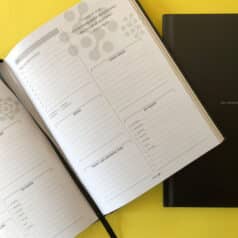This productivity planner for legal marketing is based on solid psychological principles and setting simple, achievable goals.

A Great Productivity Planner Builds on Proven Analog Affects

The best productivity planner is simple. It fits a broad range of individual work styles in a specific industry. Good planners focus on vital work that advances their vertical. For instance, a writer’s daily planner would focus on word count, research and revision. A bartender’s journal might focus on inventory, drink recipes and event planning. A marketing journal would focus on getting the word out. A marketing journal for attorneys would cover tasks specific to marketing a law firm. “The Lawyer’s Marketing Journal,” by our own Theda Snyder, does exactly that and does it well.
The “Lawyer’s Marketing Journal” takes advantage of the science behind analog tools. Writing down your day by hand is the most effective method for entraining routines. Developing routines helps to automate your day. Using a pen instead of an app ensures that your ideas remain alive and retrievable. Writing a note by hand delivers nearly 30% more retention. It ensures you retrieve that information 30% faster than notes take on your phone. In addition, journaling can enhance your sense of well-being and reduce symptoms of depression and anxiety — particularly the type of journaling that helps you set priorities and meet goals.
The “Lawyer’s Marketing Journal” is Set Up for Vision and Execution
There are three purposes for a planner and a journal: to plan one’s day, record one’s day, and think on paper. But execution is pointless without motivation and vision. Snyder designed her journal as a guide for the day-to-day execution of a marketing plan. It does this while feeding your motivation and helping you keep an eye on the endgame.
Undated Pages Make for the Best Productivity Planner
Each day’s page is undated. This might seem weird if you’re a person who uses a daily planner with the day and date on every page, like a Hobonichi. Some people prefer undated planners, especially creatives. Dateless pages are also a bonus if you buy your planner late in the year. (Throwing away four months of pages is insanely wasteful and reminds you that you put this off too damn long.)
Another boon of undated planners is how their pages don’t have to represent single days. I plan two or three days at a time, meaning my legal pad shows my tasks for the next three days. Sometimes I realize I’ve spent most of the week working from the same page. But my job is crazy pants, so it works for me. I used Snyder’s journal for a time, and it fit my insane production style. If it works for me, it’ll work for anyone.
Since she promotes the benefits of analog in the opening pages of the journal, I am a fan.
A To-Do List is the Cornerstone of Time Management
It’s a must-have feature in any productivity planner. Some experts say it’s all you need. The Lawyer’s Marketing Journal puts the to-do list in the most important section of a page: top left. There are 10 lines with right-facing delta bullets under the heading “Tasks/Accomplishments.” A legend underneath the list suggests symbols to use to organize and annotate jobs as:
- completed (x)
- migrated (>)
- priority (*)
- and scheduled (<).
Snyder offers a clean, useful tool, managing to avoid the mistake of over-complication. This is a wheel requiring no reinvention. Snyder leaves it resolutely alone, which is a good thing.
Space to Capture Notes and Great Ideas
Notes can be anything. They can be a hastily scribbled single word, like “toast,” which is cryptic and possibly food-related to anyone accidentally reading your notes but is a shibboleth that unlocks a whole book of data for you. They can be reminders (schedule Jones!), reactions (Jones—really?!), or even doodles.
The “Great Ideas” section is especially helpful and important. Some people (ahem) labor under the false belief that if an idea is good enough, you won’t forget it. But you will forget it. Canadian researchers discovered two reasons we forget: decay and interference. New ideas aren’t fixed in your mind. No matter how explosive an idea feels when you have it, it will face decay like any other thought. The second reason we forget is interference. When you have an idea, accruing similar information will obscure it. Great ideas inspire related ideas that branch out like a bramble of vines. After a short time, you’ll realize you can’t remember the original thought.
Recording Your Notions on Paper Prevents Decay and Interference

Many great thinkers and successful people carry a pocket notebook. It’s a superfast way to capture important ideas. You can’t trust your memory with your best ideas. Write them down. “The Lawyer’s Marketing Journal” provides eight lines for notes, and you should be so lucky if it’s not enough.
Snyder hopes her journal is both a long-term and a short-term tool for lawyer marketers. Short-term means the daily pages and to-do lists. However, the long-term use of the index may end up being the most useful part of the planner.
“The thing I’m proudest of is the index,” Snyder says. “It provides you with a quick and easy way to find those good ideas or to check to see if a new idea is one you’ve had already. The index is really the distinguishing feature of the book.”
Promoting Inspiration and Gratitude in a Productivity Planner
Giving thanks makes you happier. You shouldn’t need a study from Harvard Medicine to prove this because most of us have felt it. Most people have expressed gratitude and then felt connected to something larger than themselves. Wharton Business College studied two groups soliciting donations from alumni. One group followed the usual method. The other group made calls after their director expressed gratitude for their work. They made 50% more calls than the first group.
“Gratitude makes you happier and nice,” Snyder explains. “And when you’re nice, people like you more, and guess what, when people like you more, they send you business.”
Recording gratitude in a productivity planner isn’t entirely about keeping a list. It’s about establishing a habit of gratitude. This leads to a more positive outlook, which leads to greater productivity.
The “Lawyer’s Marketing Journal” adds a motivational quote in the upper right of each page. Many of the quotes are germane to the practice and principles of marketing. Some are broader, inspirational quotes from historical figures like Franklin D. Roosevelt, Karen Lamb and Steve Jobs.
Post Planning
To me, this is the most important functional part of the journal’s daily pages. These are jobs we often forget. Posting content should be a habit. Following the journal’s short list of daily tasks will develop a posting routine. This kind of routine builds a broader body of marketing content.
A Ridiculously Nitpicky Criticism
The journal is hardbound in solid black, and it has a ribbon for keeping your place. The physical qualities of the journal are all good. It has nice thick paper with no bleed, light gray printing to ease eye fatigue, and a crisp design that doesn’t upstage its usefulness. But this journal isn’t perfect. For instance, it doesn’t lay completely flat. Not at first. With daily wear and tear, it may flatten out, but right out of the box, it won’t lie open during use.
Getting a journal perfectly right is nearly impossible right out of the gate. Baron Fig, Levenger, and all productivity planner publishers honed their journals over decades of use and feedback. Snyder is leaping out of the gate with her journal. That it doesn’t lie completely flat doesn’t make it any less useful. Such criticism is, perhaps, an artifact of this reviewer’s incessant snobbery.
The “Lawyer’s Marketing Journal” Should be Part of Your Marketing Plan
Snyder plainly states this productivity planner is not meant to act as a marketing plan. The “Lawyer’s Marketing Journal” is a method. Follow its daily pages and, long before you reach day 110, you will find yourself enjoying the fruits of a successfully executed marketing plan, probably awash in clients, and clearly motivated.
Photo by Jessica Lewis on Unsplash
The Lawyer’s Marketing Journal is Available in the Attorney at Work Shop
From Theda C. Snyder and Attorney at Work, the Lawyer’s Marketing Journal is the perfect place to capture all your great ideas, write down your daily tasks, notes and accomplishments — and monitor your progress. Visit Attorney at Work’s bookshop for more information and to order.

















